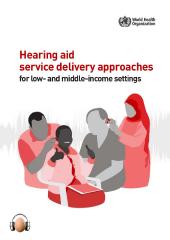NEW FROM WHO: HEARING AID SERVICE DELIVERY APPROACHES FOR LOW AND MIDDLE INCOME SETTINGS
This tool is intended to support countries in implementing community level programmes for the delivery of hearing aid services in order to increase by 20% the effective coverage of hearing technology among people with hearing loss by 2030.
t is estimated that while more than 400 million people worldwide could benefit from hearing aid use alone, only 17% get to use these devices. This gap of 83% poses a substantial global challenge as unaddressed hearing loss is a leading cause of morbidity with an annual global cost of 980 billion international dollars.
The WHO Hearing aid service delivery approaches for low- and middle-income settings is intended for use by people who plan to implement a national or subnational community level programme for the delivery of hearing aid services. It provides guidance on important factors to be considered when developing a community-level programme for the delivery of hearing aid services in low- and middle-income settings through trained non-specialists.
This document targets 2 population groups:
- children aged older than 5 years; and,
- adults aged 18 years and older.
The approaches provide directions on who should be fitted with a hearing aid; the process of assessment; the tools to be used; and the protocol for follow-up. 
Target audience
- Ear and hearing care coordinators or focal points within ministries of health.
- Public health planners.
- Nongovernmental organizations or civil society entities that provide ear and hearing care.
Download:
Hearing aid service delivery approaches for low- and middle-income settings (who.int)